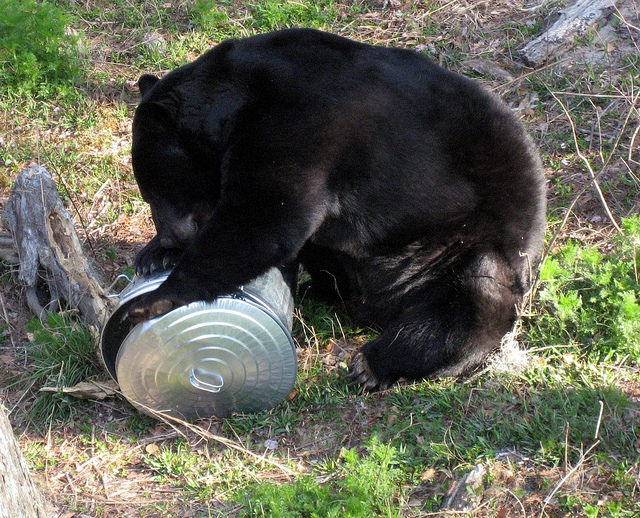
We have been happily building our cute little family coops all summer. How I have loved to watch each one be completed and established around our former garden’s perimeter. I’ve been loving the look, the ease of tending, and the happiness of my birds.
Until last week, that is, when I had a vivid dream — a nightmare, actually.
I dreamed that a black bear came out of the nearby woods (where we know for certain that they do live) and exerted her awesome strength to claw open my tarped coops and ravage my chickens. In my dream, the coops lay scattered on the lawn, overturned and broken. Chicken feathers were everywhere. Some chickens escaped into nearby woods; others were bloody casualties scattered on the lawn. It was horrendous; I could not return to sleep for hours.
In the clear light of day the next morning, my husband and I discussed the dream, and its implications. We are serious about finding the best possible breeding stock and doing highly selective breeding. We are investing time, love, and dollars into this endeavor. Whether now — when investments are relatively modest — or in the future — when years of effort have produced very expensive, high quality birds — we do not want to lose out to a wandering black bear in search of a meal.
So, we read up on this topic. We learned that black bears do indeed attack chicken coops, and with devastating results. However, bears will respect electric fences (yay!). One sets hot lines at about 24″ above ground (as well as higher or lower). The best scheme involves multiple strands, since bear paws are well insulated. We also read that it’s a good idea to slather the line with honey, so that a wandering bear will lick the line. Apparently, once a bear has registered the shock, they typically won’t try again.

Our problem then became how to electrify our perimeter. We had placed the family coops outside the garden fence, with runs extending inward. There was no good way to place electric fence around these coops and still maintain 1) the ability to mow easily, 2) create a pleasing look, or 3) create an easily-operated gate.
With a groan, we came to the conclusion that we needed to rotate our scheme 180 degrees. Our plan is to have 12 family coops in all, housing 4 breeds, divided into three families each. We had built and mounted five of these so far. We would now move all five of these family coops to the interior of the garden, mounting them back-to-back down the center, and have the runs extend outward, towards the perimeter. Then, we would electrify that perimeter.
We were grateful that the coops had been designed to be mobile, but they are still heavy. When we finish each one, it takes a minimum of two strong people to move it (using a heavy-duty wagon) to the garden area from the garage workshop. In this case, it meant disassembling the coop’s supportive legs (which had been well pounded into the ground), removing the wire that allows chickens to go under the coop), moving each coop up, around, and down over stepped garden terraces, re-pounding in supportive legs, re-leveling the coops, and finally, reworking the runs (which involved repairing openings in the garden fence perimeter and making new openings near the coop doors) and finally, rewiring the underside of each coop. We also had to reverse the tarps, since we want south-facing sun to pour into those clear vinyl panels that we incorporated. Whew!

I was no help in the heavy lifting part of the endeavor. I’m not strong, and had recently injured my back. But, in God’s special providence, my strong and willing son called a couple of days after my nightmare (and our decision to move the coops) to announce his decision to visit us with his family.
With his help, we moved the coops in two days, but it’s going to take at least a week to accomplish all of the above-listed tasks, and still longer to electrify the garden. In the picture at the right, you can see the coops moved, and the patches that were under three of the coops when they were outside of the garden fence. Chickens sure can eat green stuff down to nothing in a short amount of time. In hot weather, they love hanging out under these coops: shade and breezes! You can also see the progression of eaten-down vegetation in the runs (that have been created as each coop was erected). The lowest coop (far left in the picture) is the most recent. The only reason that there wasn’t a bare patch for the far right one is that we never cut a door for those birds to go under that coop.
As all five coops are moved now, a hidden blessing has emerged: they are even easier to tend! Before, when the plan was to line opposite sides of the 1800 sq. ft. garden with six coops each, I would go down one side, tending six coops, then truck across to the other side, and then go down it, tending the other six coops. Now, instead of my needing to go down each outside wall of our garden, the new placement will put them back-to-back in the center of the garden. Thus, I will walk down the center aisle of 12 coops in order to tend them daily: six on my left and six on my right. This will be especially welcome in winter, as I water and feed with snow on the ground. So far, as you can see, five coops are in place that will be on my left as I walk down the row.
So, even though the electric fence isn’t up yet, we sleep better at nights now, and are grateful for the added benefits of easier tending of our little flock! 🐔